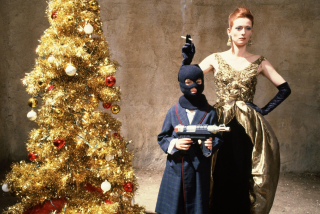How science colored our film world
- Share via
The motion picture academy’s science geeks are getting their moment in the spotlight.
“It is the Motion Picture Academy of Arts and Sciences,” points out visual effects expert Ray Feeney. Tonight, the academy will herald some of the last 100 years’ most important advancements in the moving image. “The Science and Art of Color Motion Picture -- Past and Present” will focus on topics including the transition from black and white to color, and the evolution of color technology in film. The program will feature numerous film clips to illustrate the progression.
Speakers include Randy Haberkamp, founder of the Silent Society and program coordinator at the academy; UCLA Film and Television Archive’s preservation officer Robert Gitt; Peter Anderson, a member of the American Society of Cinematographers who has worked on special venue/large format projects; and Fred Meyers, head of special projects for Lucas Digital. Also speaking is the evening’s host, Rob Hummel, senior vice president of production technologies for Warner Bros.
“It seemed like the color motion picture was something that people could easily understand and grasp,” said Feeney, an award-winning member of the academy who organized the program. “So the idea is to show a little bit behind the curtain.”
The clips to be shown include a tinted sequence from “The Roaring Road” (1919), original nitrate prints of “Gone With the Wind” (1939) and “Becky Sharp” (1935), and Walt Disney’s first Technicolor cartoon using the technique known as the three-strip method, “Flowers and Trees” from 1932.
Feeney adds that the evening will allow color aficionados a rare opportunity to witness the progress of technology over the last century, “sitting in the same theater with the same ambient lighting and the same projection on the same screen.”
“You’ll be actually able to see the varying processes as they occurred over the years,” he said, “including the latest Eastman color, the latest kind of digital technologies.”
Hummel said the evening also will touch on the creative aspect of color and how it affects storytelling. Among the clips Hummel will show to illustrate the use of color are Francis Ford Coppola’s 1988 drama “Tucker: The Man and His Dream” and Lawrence Kasdan’s 1985 western “Silverado” and 1988 drama “The Accidental Tourist.”
Hummel also will demonstrate how the most recent digital technology is helping to preserve the past with a clip from the 1938 three-strip Technicolor classic “The Adventures of Robin Hood.”
“We have developed some software [at Warner Bros.] where we can scan the Technicolor three-strip negative and realign [the strips] in software so the negatives are registered to a degree of precision that Technicolor could never achieve before,” Hummel said. “ ‘Robin Hood’ looks like it was shot last week.”
*
Film history
What: “The Science and Art of the Color Motion Picture -- Past and Present”
When: Tonight, 7:30
Where: Samuel Goldwyn Theater, Academy of Motion Picture Arts and Sciences, 8949 Wilshire Blvd., Beverly Hills
Cost: General, $5; students and academy members, $3
Contact: (310) 247-3600
More to Read
Only good movies
Get the Indie Focus newsletter, Mark Olsen's weekly guide to the world of cinema.
You may occasionally receive promotional content from the Los Angeles Times.











